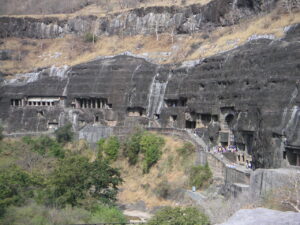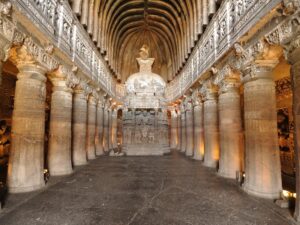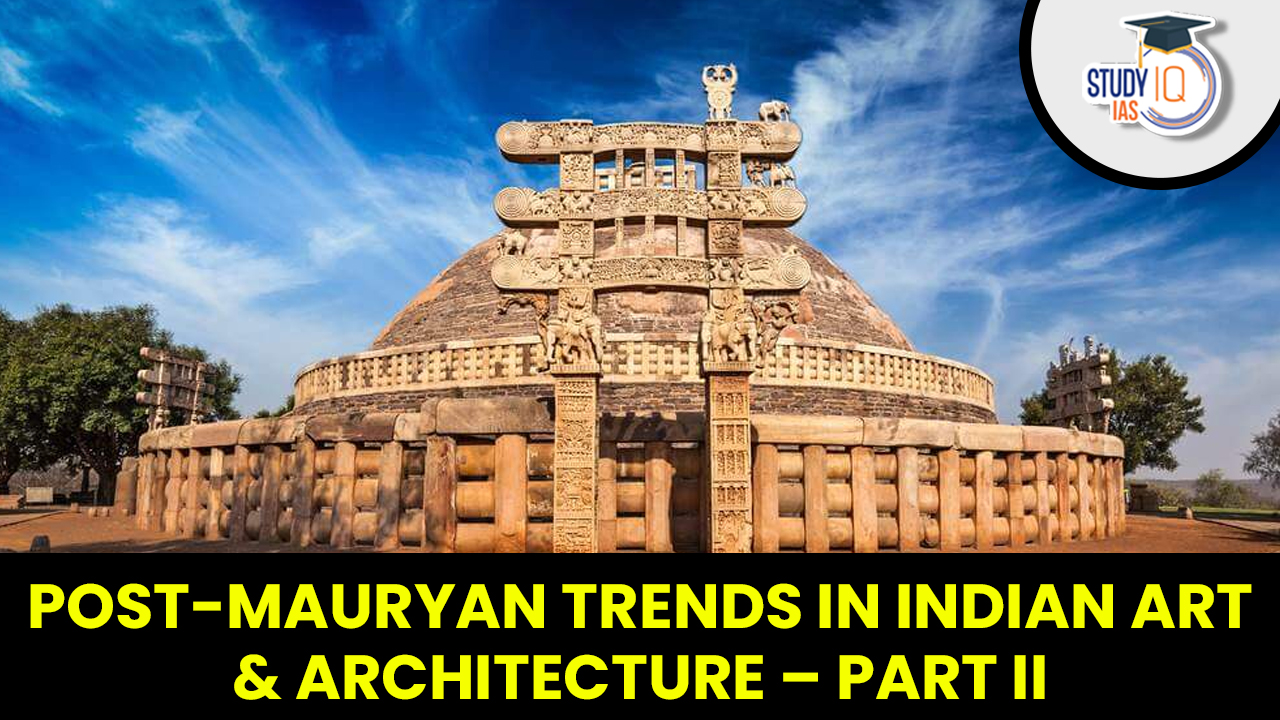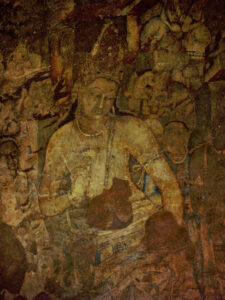Table of Contents
Post-Mauryan Trends in Indian Art and Architecture-Part II
Post Mauryan Trends: Caves in Western India
Numerous Buddhist caves dating from the second century BCE and earlier have been discovered in western India. There were three completed architectural kinds:
- Apsidal vault-roof chaitya hall (found at Ajanta, Pitalkhora, Bhaja)
- Apsidal vault-roof pillar-less hall (found at Thana-Nadsur)
- Flat roofed quadrangular hall with a circular chamber at the back (found at Kondivite)
A stupa in the back is typical in all of the chaitya caves. The conventional apsidal vault-roof plan underwent some changes in the first century BCE, making the hall rectangular and adding a stone screen wall as a front. In Karla, Maharashtra, the largest rock cur chaitya hall was unearthed. All of the caves have vihara ruins. A veranda, a hall, and cells surrounding the hall’s walls make up the vihara’s floor plan.
Many of the early vihara caves had internal decorative motifs carved into them, such as chaitya arches and vedika decorations above the cave’s cell doors. Later, the vihara had a stupa built at the back, changing its name to Chaitya- Vihara. More than 200 caverns have been excavated near the hills of Junnar, Maharashtra, but just 108 caves have been discovered in Kanheri, Mumbai.
Due to the installation of a Ganesh statue from a later era, the Vihara cave discovered at Junnar is also known as Ganeshi. Because of the absence of Buddha pictures, it was once thought that the caves belonged to Theravadins, an orthodox branch of Buddhism.
However, it is now conclusively established that the cave activity in western Deccan was a process that was ongoing and that many caves had been carved with Buddha images where the image does not presently exist. This was made possible by the discovery of the Konkan Maurya inscription, which mentions the Saka era 322 (400CE). It should be mentioned that several caverns have been transformed into contemporary Hindu sanctuaries and have grown to be important places of worship.
Ajanta Caves
Ajanta is the most well-known cave site in western India. It is situated in Maharashtra’s Aurangabad district. There are 4 chaitya caverns among its 29 total caves. It is embellished with murals and sculptures and contains a sizable Chaitya-Vihara. The only surviving example of a painting from between the first and fifth centuries BCE is in Ajanta.
There are incomplete Vihara caves in this area. Varahadeva, the Vakataka king Harisena’s prime minister, Upendragupta, the area’s ruler and a feudatory of Harisena, Buddhabadra, and Mathurasena were significant supporters of Ajanta. There are significant paintings in caves 1, 2, 16, and 17. There are numerous typological variants in the paintings. The paintings’ figures are bulky, akin to western Indian sculptures.

The process of excavating the cave and painting it took place concurrently, and the paintings’ dating corresponds to the date of the cave excavation. Nearly all of the completed excavations had pictures painted on them, although relatively few of them have survived. The paintings’ depictions of people with various skin tones indicate a diverse society. Events from the lives of Buddha, the Jatakas, and Avadanas are the themes of the paintings. Events that took place in the palace are distinct from those that took place in the bush. In Ajanta, representations of Padmapani and Vajrapani are prevalent.
Padmapani Bodhisattva
It is a painting from the final decades of the first century CE. The Bodhisattva, who is holding a Padma (Lotus), has broad shoulders and three body bends that cause the picture to move. The modelling is supple, and the body volume and shape are combined to give the appearance of three dimensions.
In the image, light shades of red, brown, green, and blue are employed. Vajrapani Bodhisattva, who is painted on the opposite side of the picture, is depicted. He is crowned and has a vajra in his right hand. Bodhisattvas are shown as protectors of shrines. Other caves also include similar images. However, the artwork in Cave No. 1 is among the best Ajanta paintings that have survived.
Mara Vijaya, Ajanta Cave No. 26
In the Ajanta caves, the Mara Vijaya theme has been painted, but only cave no. 26 has a sculptural portrayal, which is carved on the right wall. In the middle of the panel, surrounded by Mara’s army, is a representation of the Buddha. The occasion is a component of enlightenment, while Mara stands for desire.

The Buddha experienced this when he became enlightened—it is the personification of mind. As a symbol of his generosity, the Buddha is depicted with his right hand pointing down towards the earth. The representation of Mara is seen pondering how to agitate Siddhartha, the Buddha’s previous name before attaining enlightenment.
Ellora
Ellora is another significant cave site in Aurangabad. It is 100 kilometres from Ajanta. There are 32 caverns that are Jain, Brahamanical, and Buddhist. Due to the presence of monasteries related to the three major religions that date from the fifth to the eleventh centuries CE, it is a unique artistic and historic destination in the nation. It is also exceptional in terms of stylistic eclecticism, or the blending of several styles in one location.
Many Vajrayana Buddhist images can be found in twelve Buddhist caves. Buddhist caves are large and have one, two, or three stories. Ellora’s triple narrative is one of a kind. When pillar designs reach Jain caves (9th century CE), they become extremely intricate and the ornamental features develop significant protrusion. Shaivism is the primary focus of the majority of the Buddhist caves.

Here, Vishnu’s various avatars are also shown. The name Kailas Leni/Kailasa temple refers to cave number 16. It is a single-rock temple that has been carved into it. The eighth century CE saw its construction. A significant work of Indian art is the massive sculpture of Ravana attempting to move Mount Kailash with all of his power.
Elephanta Caves and Other Sites
On Elephanta Island, close to Mumbai, are the Elephanta caves, which were once a Buddhist sanctuary but are now primarily Shaivite. Ellora and it are both contemporary. The other notable cave site is Bagh, which is close to the MP city of Indore. The Bagh cave also has artwork, including a painting of a group of dancers that resembles the Gujarat-born Garba Dance of North India.

The tradition of rock-cut caves persisted in the Deccan, and today they can be found not only in Maharashtra but also in Karnataka, primarily at Badami and Aihole, Andhra Pradesh in the vicinity of Vijayawada, and Tamil Nadu, primarily at Mahabalipuram, under the patronage of the Pallavas. These were all built under the patronage of the Chalukyas. When the nation’s early history depended on widespread popular patronage, it leaned increasingly on political patronage after the sixth century CE. Here is a sculpture of Maheshmurti, which features the heads of Bhairava and Uma on either side of Shiva in the centre.
Post Mauryan Trends: Caves in Eastern India
Buddhist caves have also been discovered in eastern India, primarily along the coasts of Andhra Pradesh and Odisha. Guntapalle in the Eluru district is one of Andhra Pradesh’s most important places. One of the rare locations where caves, viharas, and structural stupas have all been excavated together is Guntapalle. Rampaerrampallam is the other significant location in addition to Guntapalle.
A sizable rock-cut stupa was hewn out of a mound in Ankapalli, close to Vishakapattanam, between the fourth and fifth centuries CE. The largest rock-cut stupas in the nation may be found there, making it a special location. The caverns at Udayagiri and Khandagiri in Odisha are another significant cave location. These scattered caves contain writing from the Kaharvela Kings. The caves were intended for Jain monks, according to the inscription. Here, there are many single-cell excavations. A succession of Chaitya arches and stories from the local folklore are used to embellish the cell’s upper portion.



 SHANTI Bill 2025: India Opens Nuclear Se...
SHANTI Bill 2025: India Opens Nuclear Se...
 Revamp of MGNREGA Scheme 2025
Revamp of MGNREGA Scheme 2025
 National Energy Conservation Awards 2025
National Energy Conservation Awards 2025

























